All the Travel Trips You Need to Make Your Bali Adventure the Best
Considering a tropical escape to Bali? You’re in for an absolute treat!
Known as ‘the island of the gods’ (and for good reason!), Bali has a special kind of magic that gets under your skin in the best possible way.

This tropical paradise is known for its vibrant culture, friendly locals and stunning landscapes (my personal fave are the rice fields in Ubud, especially at night when the fireflies come out!).
Whether you’re seeking adventure, wellness, relaxation, culture, fitness or a bit of everything, Bali has something to offer every traveller and is a dream destination for many. Some things are popular for good reasons! In fact, I loved it so much, I stayed there for 7 weeks exploring the depths of this island. I didn’t want to leave!
But before you go chasing waterfalls and soaking up sunsets, here is some top travel advice to make the most of your journey. Keep reading to soak up my best Bali travel tips, with everything from visa requirements to budgeting!
Pre-Trip Planning For Bali
Visas & Immigration:
My first Bali travel tip is all about visas and immigration, so you can make sure that when you arrive at the airport, they definitely let you into the country!
Understanding Bali visa requirements is essential before you leave for your adventure! So here I have laid out the main types of Bali visas that will likely be relevant to you.
The main kinds of visa are:
- Visa on Arrival/Visit Visa (30 Days): This was my personal choice—no hassle or additional prep before arrival, which eased the pressure for me while on the go! This can be extended for an additional 30 days, which I did easily with the help of a local visa service. Once extended, it cannot be extended again while you are in Indonesia.
- 211A Bali Visit Visa/Single Entry Tourist Visa (60 Days): Opt for this visa if you know you will be visiting for 60 days or more. This visa can be extended twice for 60 days at a time giving you a maximum of 180 days in Bali.
- Tourist Multiple Entry Visa (Valid for 60 days within a period of 1, 2 or 5 years): If this is your first trip to Bali, this probably won’t be for you. But you never know! If you can’t get enough of Bali and want to keep coming back, this will likely be the choice for you. This visa valid for 60 days can also be extended twice, up to a maximum of 180 days.
Check whether your nationality is eligible and fits the requirements for these Bali visas here! And don’t forget, as with most destinations, remember to check that your passport has 6 months of validity remaining from the day you plan to arrive.
Flights & Getting There:
The best time to fly to Bali really depends on your priorities!
If you’re on a budget, consider going during the low season from November until April. However, you should know that this is the rainy season, with monsoon downpours peaking in December and January.
To be honest though I spent a lot of time in both Thailand and Indonesia during rainy season and its not *that* bad. Its still hot, its pretty humid, and the waterfalls are insane.
If you prefer to skip the rain, the best time to fly to Bali for you is between May and October. This is Bali’s high season so you can expect lots of tourists enjoying the sunny days. Prices will be higher during these months so consider booking your flights several months in advance and keep an eye out for promotions from major airlines.
To get the best of both worlds, the best time to fly to Bali is shoulder season – these are the months that come just before and after the high season – April-May and October-November. Prices will be slightly lower, weather should be pretty good and there’ll be slightly fewer tourists.
Always make sure when booking flights that you use an incognito tab and don’t agree to cookies as often transport sites will hike up their prices for repeat visitors. I always use Skyscanner or Google Flights to look at the best dates and times to fly and to ensure that I get the best deals possible.
Accommodation:
There are so many unique places to stay in Bali, from boutique hotels and eco-resorts to traditional Balinese villas.
As far as my own experiences go, my stay in this remote cabin near Lovina in the north of the island definitely comes in pretty high in my list of unique places I’ve stayed in Bali. Nestled in the jungle and off the beaten tourist track, it was truly an unforgettable experience.
However, Bali, and in particular Ubud, boasts many hostel options if you’re looking for something more social.
Many hostels offer dorms for those on a budget and private rooms for those with some extra cash. Ubud is a great shout if you are looking for culture, nature, wellness and spirituality. While the centre can be extremely busy, a look to the outskirts, for example, Penestanan, will offer more tranquillity without compromising on the rest!
I used Hostelworld to source the hostels I stayed in while I was there. I would recommend downloading the app. Its also got a chat feature, so you can connect with people staying in your hostel or area!
if you’re after a more vibrant nightlife, Canggu and Seminyak are good options, and Uluwatu being a prime spot for surfers. I used booking.com to source my stay in this Canggu guesthouse!
Packing Essentials:
Now you have an idea on where to stay, the next bit to work out is what to pack for your Bali trip…
Without focusing too much on specifics here if my suggestions for essentials you’ll want throughout your stay:
Clothing
- Breathable and lightweight: Since Bali is a tropical destination, pack plenty of lightweight, breathable clothing like t-shirts, shorts, and sundresses.
- Long-sleeved shirt and pants: Even though the weather is warm, you might want to pack a light long-sleeved shirt and pants for cooler evenings or unexpected rain showers.
- Swimwear: Pack at least 2 swimsuits, so you always have a dry one on hand!
- Sarong: A sarong is a versatile piece of clothing that can be used as a beach cover-up, a scarf, or a skirt. It is also required for entering some temples in Bali.
Footwear
- Sandals or flip-flops: These are essential for wearing around the beach and pool, or for shared showers (no one wants to get a fungal infection…)
- Comfortable walking shoes: for exploring temples and villages.
Essentials
- Hat: to protect you from the sun, trust me when I say you don’t want a sunburnt scalp.
- Sunglasses: A good pair of sunglasses is essential for sunny days in Bali.
- Sunscreen: Get at least SPF 30, and consider investing in one that’s reef-safe. You can buy this in Bali but be aware that most will have skin whitening agents in them.
- Insect repellent: To help keep mosquitoes and other bugs at bay.
- Reusable water bottle with a filter: Stay hydrated with a reusable bottle. Ones that have built in filters are the best as they offer protection from the dreaded Bali Belly.
- Travel adapter: I recommend getting a universal adaptor.
Other essentials
- Copies of important documents: Make copies of your passport, travel insurance, and any other important documents in case you lose the originals.
- Medications: any regular meds you’ll need but also over-the-counter medications like pain relievers and diarrhoea medication.
Optional items
- A small flashlight or headtorch
- A book or e-reader
- Ziplock bags for laundry or wet clothes
- Dry bag for day trips
Budgeting for Bali:
While more expensive options have cropped up over the last few years, it is still possible to find affordable travel options for Bali.
Look out for hostels aimed at backpackers – as of June 2024, hostels in Ubud and Canggu can be found for as little as $3-4 per night! You’ll likely get better prices if you stray from the beaten path – consider places like Kuta or Legian over Ubud.
Look into free activities, such as relaxing on the beach, visiting temples (entrance fees are usually minimal), hiking waterfalls, and exploring rice terraces. If it’s culture and architecture you’re into, entry into the astounding Ubud Palace is also free!
Transportation options like scooters are available for around $3-4 per day if rented monthly. This is my preferred way to get around as you can immerse yourself in the culture and natural beauty of the island with the freedom to explore wherever you want.
Street food and local warungs (small family-owned restaurants) offer delicious and inexpensive meals, with prices starting for just over $1 for a tasty plate of noodles. Be sure to choose places that seem popular with the locals, this should help you avoid getting sick.
Where there is a will, there is a way; don’t be fooled by the mainstream, affordable travel options for Bali still exist!

Getting Around Bali
So you’ve mastered the planning stage and you’ve made it to Bali!
The next lot of Bali travel tips are all about how to cope once you’re here. We’ll begin with travel and how to manage getting from place to place as this is the first thing you’ll need to do as you leave the airport and head to your accommodation.
Renting a Scooter:
If you’re seeking a scooter rental guide for Bali, look no further – we have you covered! Renting a scooter is one of the most popular ways to explore South East Asia. It’s cheap, convenient and allows you to visit off-the-beaten-path destinations. It also tends to make getting around a lot quicker than hiring a car.
Bali is packed with scooter rental shops, so finding a scooter won’t be difficult. Rates tend to decrease the longer you rent, with weekly and monthly rates available. Don’t forget to take along some extra cash in case you are asked for a security deposit. Some places might ask for your passport, however it is always better and safer to negotiate for a cash deposit instead.
Technically (legally) you’ll need to have your international driver’s licence/permit to drive in Bali. Without it, there’s a chance you’ll face fines with the local police, and if you have an accident you likely won’t be covered by your insurance without it. I have literally never been asked to show any sort of driver’s licence when renting a scooter though.
Forget your helmet however, and you almost certainly will be fined if spotted! With traffic jams and congestion on the rise in Bali, especially in Canggu, I would definitely recommend wearing your helmet for safety.
Finally, the most important tip I can give you in this mini scooter rental guide for Bali is be confident and go with the traffic flow!
Taxis & Ride-Sharing Apps:
When it comes to taxis and ride-sharing apps, you have several options in Bali that replace Uber. Grab vs Bluebird? Bluebird vs Gojek? How to choose?!
Personally, I found Gojek to be less used than the popular Grab, and with that came slightly better rates and more availability, especially when the rain poured! It’s advisable to check the weather when travelling around the island, as many drivers take breaks in the heavy rain.
However, some ride apps in Bali, such as Grab and Gojek, face rejection by local communities due to concerns about competition with traditional transportation providers and the perceived impact on local businesses and livelihoods. With this in mind, sometimes a local taxi or the more locally accepted Bluebird taxis (which come with a metre) may be a better option. Local taxis do tend to be a bit more pricey than the apps, so be sure to barter!
Public Transportation in Bali:
While there are rumours of plans for an underground metro system, for now, Bali’s public transportation system is mainly limited to buses. So here I will lay out a Bali bus system guide!
If you’ve just arrived on the island, many accommodations offer a shuttle service from the airport to your destination, which is a good shout if you are travelling with luggage. If not there’s always loads of taxis on standby outside of the airport but these will be pricey.
Once you have fully landed and are ready to explore, Bali’s bus system mainly includes;
- Trans Sarbagita, a bus rapid transit system in and around Denpasar. This is a cheap and reliable way to get around but it can be slow and crowded.
- Shared minivans called Bemos. These usually operate within individual towns and tend not to have set schedules. However, ask a local and they will be sure to help you find out when and where to wait for this cost-effective option.
- Kura-Kura Bus, which services popular tourist areas in the south of the island up to Ubud. This option is a tourist bus with predetermined stops. Buy a ticket onboard or online up to 2 hours before departure!
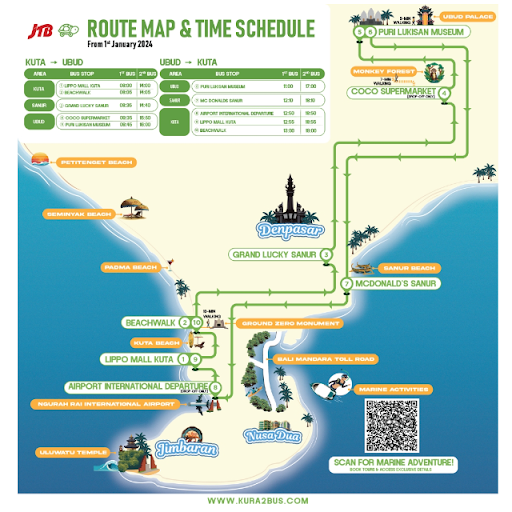
A second shuttle bus called Perama, which services as far north as Lovina and as East as Tulamben. Tickets must be booked online 1 day before departure and is suitable for those travelling in a group, as tickets must be reserved for at least 2 people.

What to Do in Bali
Best Beaches & Surfing in Bali:
Bali is renowned for its world-class surfing spots. Some of the best beaches for surfing in Bali include Uluwatu, Padang Padang, Canggu and Bingin (where many local surf competitions take place). These breaks are best during the dry season (April to October) when the swells roll in from the Indian Ocean.
You’ll be able to find surf that suits all levels around the island but for beginners the best beaches for surfing in Bali are Kuta, Seminyak, Canggu, and Berawa.
For a more relaxed beach day, you’ll want to check out Seminyak, Jimbaran, or Nusa Dua, where you can enjoy sunbathing and swimming. Definitely try out snorkelling and try to spot some of the huge rays that populate the waters!
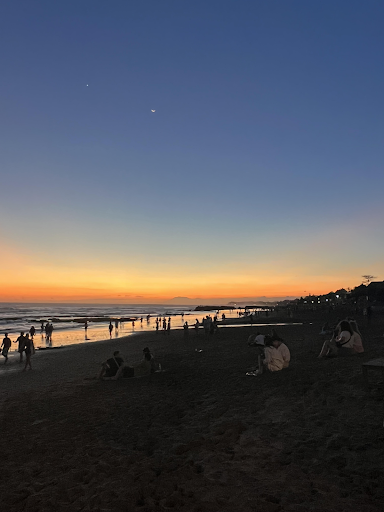
Must-See Temples & Cultural Activities:
No trip to Bali is complete without visiting its stunning temples. Must-see temples include Tanah Lot, Uluwatu Temple, and Besakih Temple.
I really recommend Pura Tanah Lot (“Temple of the Land in the Sea”) as its one of the most iconic temples in Bali, sitting on a rock formation in the ocean.
Besakih Temple is the “Mother Temple” of Bali and is located on the slopes of Mount Agung, Bali’s most sacred volcano. This temple complex is a collection of 23 temples and offers some pretty stunning views of the surrounding countryside.
Personally, some of the must-see temples in Bali include the water temples such as Pura Tirta Empul. Many temples offer the chance to take part in a water purification ceremony which is a unique cultural experience not to be missed! You can bathe in the sacred pools for purification and blessings.
The most important thing to remember about visiting the temples in Bali is to dress modestly. Knees and shoulders should be covered (this is where your sarong comes in handy!). Often you can rent cover-ups at temple entrances.
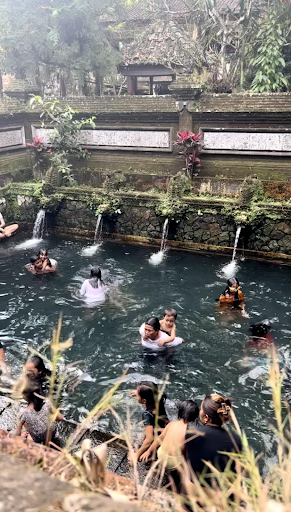
Adventure & Outdoor Activities:
Whether it’s the best Bali hiking tours you’re after, or riding a bike along a tightrope, Bali offers an adventure for every traveller.
One of Bali’s most famous hiking tours rightfully includes the early morning trek up Mount Batur to see the sunrise over this magical island. Starting in the early hours of the morning, this 2-3 hour trek does require an intermediate level of fitness.
If you’d like something more leisurely, you can spend the day at Alas Harum’s rice fields, trying out Bali’s jungle swing if you dare, before relaxing in their pool.
For me, I absolutely loved exploring the Blue Lagoon and Aling Aling waterfalls near Lovina. The calming blue lagoon was a great place to relax after trying out Aling Aling’s waterfall slide and 5 and 10-metre jumps (I wasn’t brave enough for the 15-metre!).
If all of that isn’t enough for you, then you’re in luck! With plenty of diving, snorkelling, ATVs to rent and monkeys to visit, you will certainly not be bored.
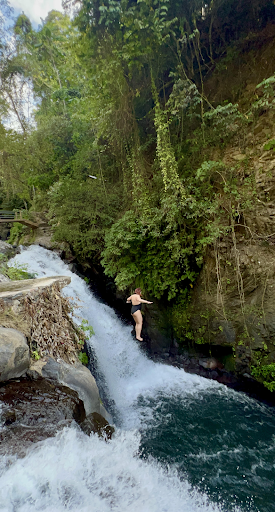
Picture Perfect Yoga & Wellness Retreats:
For those seeking relaxation and wellness, Bali, and in particular Ubud, is a top destination for yoga retreats and wellness centres. From yoga teacher training, personal development workshops and sound and energy healing, this is the perfect place to wind down and connect with your soul.
Ubud offers some of the most unique settings for yoga retreats and wellness. I frequented the Yoga Barn as the weekly schedule was varied, offering a bit of everything in addition to an onsite cafe and chill-out areas. However, if you fancy digging a bit deeper below this surface, I would recommend taking a look at this WhatsApp chat to find unique offerings such as cacao ceremonies, breathwork and ecstatic dance.
Day Trips from Bali:
No trip to Bali is complete without a day trip to one of the many neighbouring islands – whether it’s a trip to the Nusa islands for some beautiful beaches, Lombok for surfing, or a party trip to Gili Trawangan.
It’s pretty easy to buy boat tickets anywhere on the island and they usually include a shared taxi ride directly from your accommodation, making a day trip easy peasy!
One word of caution – always check the weather. If the sailing conditions aren’t ideal, be prepared to stay on the island a few days longer than planned until the boats set sail again. I mean…I can think of worse things than being stranded on a stunning tropical island but if you’ve got other things booked or flights to catch…
The Nusa Islands day trip, including Nusa Penida, Nusa Lembongan, and Nusa Ceningan, is probably the most popular option. Aside from the famous viewpoint (which is defo worth it), Nusa also offers stunning landscapes, crystal-clear waters, and opportunities for snorkelling, diving, and exploring picturesque cliffs and beaches.
Lombok is becoming increasingly popular, with many travellers enjoying its quieter, less touristy island life and surf-ready seas.
I personally enjoyed a few nights on Gili Air, a little less party-central than Gili T, this oasis boasted some of the nicest beaches I had ever seen. With cars and bikes swapped out for horse-drawn carriages, this tiny island (you can walk one side to the other in less than 30 minutes) was unlike anywhere I’ve been. I even almost touched a turtle on a snorkelling trip! 10/10 would recommend.
Food & Dining in Bali
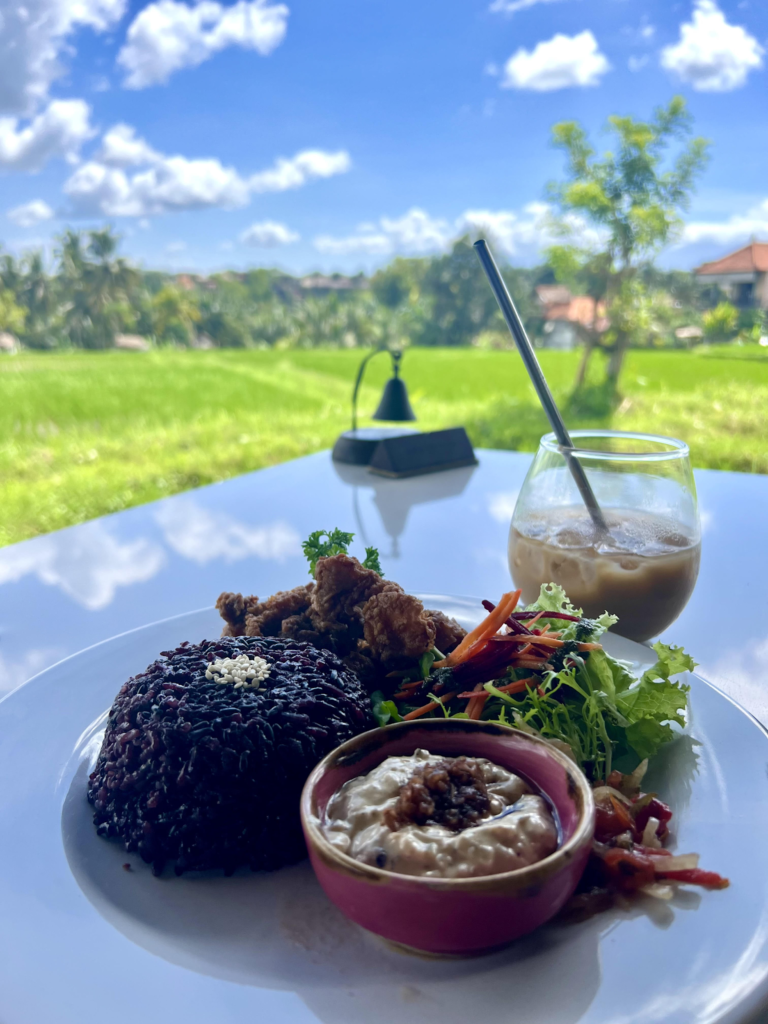
Balinese Cuisine:
Influenced by Indonesian traditions and infused with fresh, local ingredients, the food in Bali is pretty special.
Just like many Asian countries, rice is the foundation of most Balinese meals. Steamed white rice (nasi putih) is the most common variety, but there’s also nasi goreng (fried rice) and nasi campur (mixed rice with various toppings).
These are some of the most popular dishes you’ll find:
- Lawar: This is a salad of minced meat with grated coconut, vegetables, and a unique spice blend.
- Babi Guling: super popular, babi guling is a whole suckling pig slow-roasted to crispy perfection. The meat is served with various accompaniments like rice, vegetables, and a rich pork soup.
- Pepes Ikan: This features fish steamed in banana leaves with a fragrant spice paste. The result is a earthy and slightly sweet delicate dish.
- Sate Lilit: A unique take on satay, sate lilit uses minced meat (usually chicken, fish, or seafood) mixed with spices, lemongrass, and kaffir lime leaves. The mixture is then skewered and grilled.
Vegetarian & Vegan Options:
I know I just discussed things like suckling pig but I am actually vegetarian and I found some of the best vegan restaurants ever in Bali.
The staff at Siboghana Waroeng in Ubud almost knew my name, I was in there so often! This vegan restaurant offers traditional Balinese cuisine for roughly $1.50. I would especially recommend the Mie Goreng.
Another personal favourite, Veggie Stall, Warma, offered the most delicious made-from-scratch noodles and dumplings for roughly the same price.
More fantastic meatless restaurants can be found in Seminyak, Uluwatu and Canggu, serving creative and delicious dishes using fresh, local ingredients.
Tempeh and tofu are the most popular meat substitutes in Bali.
The dish Gado-gado is a personal favourite of mine: a salad with steamed vegetables, peanut sauce, and a boiled egg (omit for vegans).
Street Food & Local Markets:
Bali has a fantastic street food scene. Sample local favorites like nasi goreng (fried rice), bakso (meatball soup), and satay (skewers of grilled meat). It’s a delicious and budget-friendly way to try new things.
Some of the best street food in Bali can be found in Gianyar Night Market, Sanur Night Market, and the Pasar Senggol. Here you can enjoy a variety of snacks and meals, from satay and bakso to fresh fruit and traditional desserts.
Fine Dining & Romantic Restaurants:
If it’s a special night out you’re looking for, the island boasts numerous fine dining restaurants for a romantic dinner in Bali. Treat yourself to a memorable dinner with ocean views in Jimbaran, or enjoy a candlelit meal in the lush surroundings of Ubud.
There are loads of award-winning restaurant about from Kayuputi (Nusa Dua) to Mozaic Restaurant (Ubud), and they offer a range of cuisines.
Choosing from either traditional Balinese food, a modern fusion option or something more international like Indian or Italian cuisine, you’re sure to find something to suit that special someone.
Other Travel Tips Bali
Sustainable Travel in Bali:
Eco-friendly travel practices are a great way to help preserve Bali’s natural beauty and support local communities. If this sounds like it could be for you, then checking out some of Bali’s eco-friendly accommodations is a good shout. Look for hotels with certifications like Green Globe or EarthCheck. These hotels typically use energy-saving measures, water conservation techniques, and locally sourced materials.
I’ve already mentioned bringing a reusable water bottle to cut down on plastic waste, and reef-safe sunscreen to protect the ocean life, but there’s loads of other ways to make your trip greener.
Choose eco-conscious tours: Support tour operators who prioritize responsible tourism practices. Look for tours that use local guides, minimize waste, and respect the environment and wildlife.
Avoid exploitative animal encounters: Unfortunately, some animal tourism activities in Bali exploit animals for entertainment. Do your research and avoid activities that involve riding elephants, taking photos with chained animals, or watching animal shows.
You can also support local businesses with your purchases, though avoid souvenirs made from unsustainable materials like coral or sea turtle shells. Look for locally-made crafts from recycled materials or natural fibers.
Alternatively, if you want some more hands-on experience, consider volunteering with a local organization working on environmental conservation efforts in Bali. There are many projects dedicated to protecting sea turtles, coral reefs, or endangered animals.
Money & Currency Exchanges:
The local currency in Bali is the Indonesian Rupiah (IDR). It’s advisable to exchange money at reputable currency exchange counters or withdraw cash from ATMs (fees are typically between $2 and $5).
The latter was my choice as my bank does not charge any ATM fees and it meant I didn’t have to carry around large amounts of cash. While skimming isn’t massively common, it can happen so it’s wise to use bank branch ATMs to reduce the chances of this happening.
Its better to exchange money in Bali than in your home country as you’ll likely get batter rates on the currency exchange.
Credit/debit cards are widely accepted in most tourist areas, but always carry some cash for smaller transactions and be wary of surcharges where cards are accepted.
Staying Healthy:
Before you leave, you might want to check if you need any vaccinations for Bali trips. Whether routine vaccinations or additional vaccines like Hepatitis A, Typhoid, and Japanese Encephalitis, it’s much better to prevent yourself from getting sick where possible to prevent any chances of ruining your holiday.
I think everyone has heard of Bali Belly by now! Luckily for me in my 7 weeks there I didn’t get sick at all. However, I was sure to drink bottled or filtered water. I also used insect repellent to prevent mosquito bites, (you can get some really great and cheap repellent from Circle-K!) and practised good food hygiene!
Make sure you stay hydrated, as the heat and humidity in Bali can really get to you.
My biggest tip for staying healthy in Bali is to listen to your body and take it easy if you start to feel run down or tired. I know its tempting to push through and make the most of every second but you’ll only be doing more damage in the long run and Bali will always be there!
Bahasa Indonesia Phrases:
The locals in Bali have very good English, however learning a few basic Bahasa Indonesia phrases will make your travels so much easier and help you connect with locals.
Obviously you don’t need to go out and try to become fluent but learning just a few phrases can make all the difference. Plus locals really appreciate it when people make an effort.
Basic Bahasa Indonesia for tourists includes:
- “Terima kasih” – Thank you
- “Selamat pagi” – Good morning
- “Berapa harganya?” – How much is this?
Bargaining in Bali:
Haggling is expected in most markets around South-East Asia, especially for foreigners and Bali is no different. Vendors typically will inflate prices if they get the sense that you are not from around there so to avoid getting ripped off you will need to be assertive and confident in your bargaining.
So, you want to know how to haggle in Bali?! Start by offering about half, or just over, the asking price and negotiate from there. Often if you put the item down and go to walk away the seller will drop the price for you so they don’t lose a sale.
The most important tip might be to always remain polite and respectful. Offer too low, and the vendor may be offended! I also think a smidge of humour goes a long way while haggling…
Don’t take it too seriously, and if they do end up charging more than you’d like it’s worth remembering that even the traveller with the tightest budget probably has more money in their pocket than many of the locals. You could afford to fly all the way over here after so what’s an extra $2 or $3 on a souvenir?
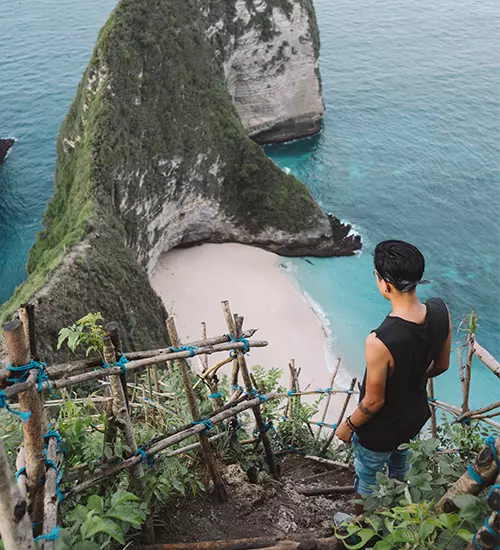
Embrace the Experience
Bali is a truly incredible destination for any kind of traveller. Whether you’re a backpacking Becki or a luxurious Larry, Bali really does cater for all. By planning ahead and following these tips, you’ll be well-prepared for an unforgettable adventure on this beautiful island.
We’ve only scratched the surface of what Bali has to offer. What aspects of Bali intrigue you the most? Share your thoughts or questions in the comments below – your insights might just inspire someone else’s journey.
For more top travel tips you can check out this handy travel guide filled with advice for every type of traveller.
Have more questions about Bali, travelling, or the nomad life?
Get in touch with us using the buttons below!
Safe travels!
Team DNA 🙂




